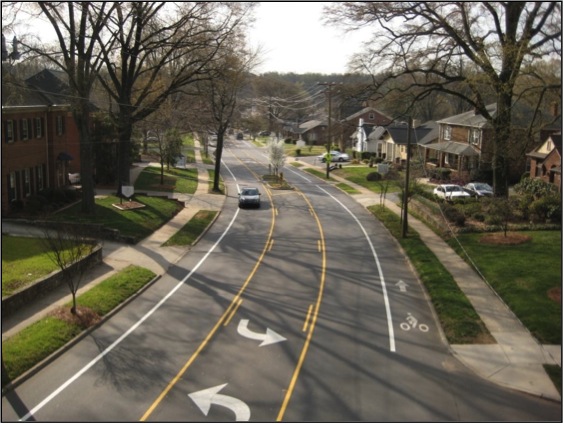Streets that are designed and operated to enable safe access for all users, including pedestrians, bicyclists, motorists and transit riders of all ages and abilities. Design features are intended to make it easy to cross the street, walk to stores, walk, bicycle, or take transit to work, and generally enhance the walking, biking or driving experience. These features, in turn, have positive economic development impacts by lifting adjacent property values.
Why is this important to your community?
Walkability and transportation choice were among the top proprieties identified through the CONNECT Our Future process. There are opportunities to convert short trips from driving to walking or biking. Nationally, 39% of all trips in 2009 were less than 3 miles. However, incomplete streets – designed only with cars in mind – limit choices for walking, biking, and public transportation. There are many potential benefits of rethinking the way our streets are designed. For example, by incorporating complete streets principles, those without access to a car can be more independent, communities can reduce bicycle and pedestrian fatalities, and residents can incorporate options for active transportation into their daily lives, thereby achieving health benefits while reducing their commute costs.
Skip directly to
How Does It Work?
Resources
Using the Tool
Partners
Where Has It Worked?
Where is it appropriate to use?
What priorities does it address?
What other tools are related?
How does it work?
The key to creating complete streets is design—incorporating such features as bicycle lanes, “safe havens” in traffic islands for pedestrians crossing the street, widening sidewalks to accommodate strollers and walkers, and adding street trees and benches that make it attractive for pedestrians to choose to walk rather than drive. Design improvements seek to balance the safe utilization of public rights-of-way between transit, automobiles/trucks, bicycles, and pedestrians. By adopting local policies and design guidelines that support complete streets, a municipality directs its transportation planners, engineers, and developers to create streets and public spaces that are enjoyable and safe for all users. Complete street designs work in conjunction with adjacent land uses to create vibrant communities. The goal is to change the everyday decision making processes that result in incomplete streets, and instead ensure that every transportation project will make streets safer and more approachable for all users.
Resources
- Introduction to Complete Streets Presentation, Smart Growth America
- Complete Streets: Best Policy and Implementation Practices, American Planning Association
- Complete Streets Resource Toolkit, SACOG and Complete Streets Coalition
Ready to get started?
Using the Tool
- Review existing plans and policies. Does your community reference complete streets in transportation and land use plans?
- Consider options for implementing complete streets in your community. Consider forming a working group and coordinate with municipal and county planning and transportation department staff, the regional COG, the state Department of Transportation, health professionals, local pedestrian and bicycle organizations, landscape architects or urban designers, businesses owners, and residents to select a preferred program approach. There are several program scales and options that could be considered:
- Adopt a local complete street policy. The Complete Streets Policy Workbook provides a summary of different types of polices (e.g., resolution, city, plan, legislation) and guidance on creating an implementable vision.
- Develop complete street guidelines for different types of streets and/or by location. The Charlotte Urban Street Design Guidelines provide a good example of guidelines for different street types and integration with the city’s land development ordinances.
- Identify key corridors, districts, project areas, or the entire jurisdiction for the applicable policies, then identify potential catalyst projects and funding options.
- Revise zoning and subdivision codes to be consistent with the community’s complete street policy and/or guidelines.
- Include Complete Street Policies in the Metropolitan Transportation Plans (MTPs) adopted by the MPOs
- Provide budgetary and policy support for the program or policies. This could include education to property owners and developers about the complete streets policies, priority rankings in capital improvements planning, and support for grant applications and research.
Partners
- Advocacy Groups
- Community Development Organizations
- Developers
- Elected Officials
- Housing Authorities
- Landscape Architects, Planners, and Urban Designers
Where has it worked?
Charlotte Urban Street Design Guidelines (USDG) - Charlotte, NC
About the Program
Adopted in 2007, Charlotte’s Urban Street Design Guidelines (USDG) focus on providing the best achievable street design to accommodate growth, create transportation choices, and maintain livability. The guidelines have won several awards, including the EPA’s National Award for Smart Growth Achievement in Policies and Regulations, and have been featured as a best practice by the American Planning Association. To implement the city’s goals, the guidelines include a street classification system that is context based considering different types of land uses, traffic speeds and congestion, and evaluates features that influence the safety and comfort of pedestrians and bicyclists (e.g., crossing distance, crosswalks, bike lanes, traffic-signal timing).
Why it works
In practice, the implementation of the guidelines in redesigning streets includes a careful analysis of congestion over several hours, rather than only at peak travel times. Data on crashes, speeds, and volumes at peak periods are collected before and after improvements are made to ensure that the guidelines result in positive impacts. Charlotte revised its Subdivision and Zoning Ordinance in 2010 to incorporate the guidelines to direct how private development will impact street design. In addition, the implementation of the new standards has been incremental in its approach, and as a result has gained support from developers and the community.
Downtown Gastonia Streetscape & Public Realm Plan - Gastonia, NC
About the Program
Gastonia’s Downtown Plan, adopted in 2010, focuses on streets, sidewalks, and other public areas that provide accessibility to all, promote safety and security, and offer green public spaces and greenways. Created through a public visioning process that included a 2-day design workshop and walking tour of downtown, the plan includes conceptual corridor design guidelines for several key streets and public spaces in downtown. In 2011, the Marietta Street Bridge was redesigned to include a pedestrian/bike path and a reduction in vehicle travel lanes from four to two with a center turning lane. The pedestrian/bike path creates a linkage to the Carolina Thread Trail and improves access to downtown. The new design includes decorative walkways, street trees, pedestrian scale lighting, and reduction in travel speeds across the bridge. The bridge redesign supports the city’s overall vision for a downtown that includes a variety of retail destination, cultural and civic activities, and supports active living principals of walking and biking.
Why it works
The project was funded through a federal grant to renovate the Marietta Street Bridge in 2009 and implemented through a partnership with NCDOT. The redesigned bridge project serves several purposes by helping to revitalize and bring activity to downtown, link to the regional asset in the Carolina Thread Trail, and provide new options for walking and biking in the community.
- Community Development Organizations




